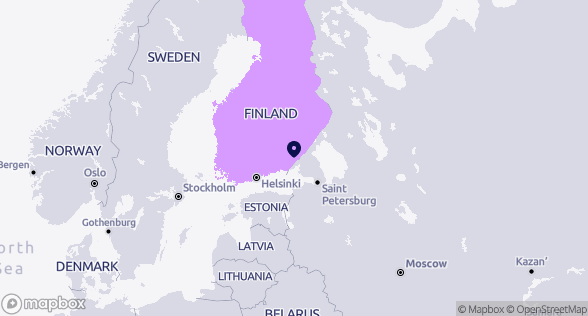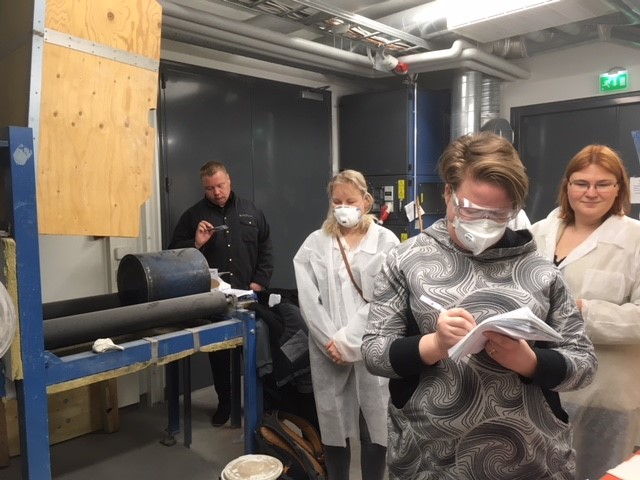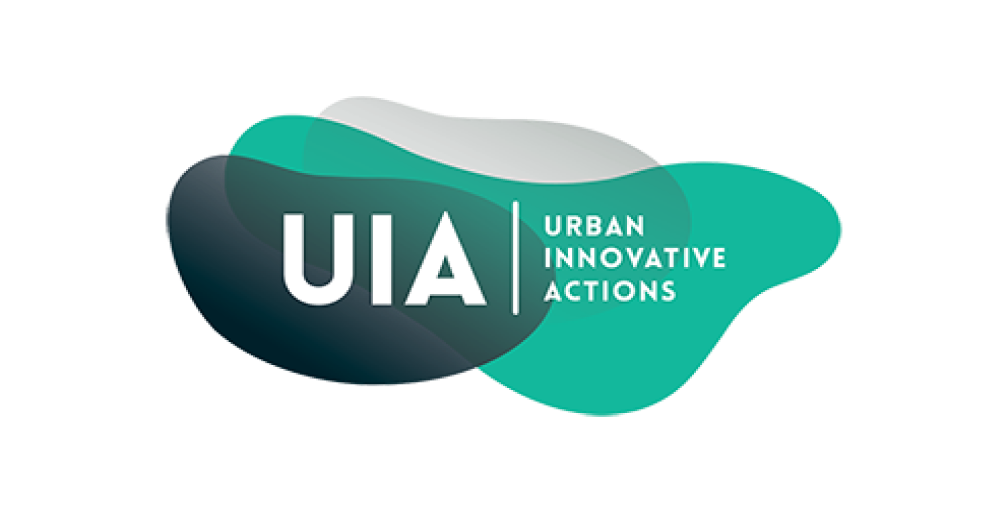
Lappeenranta
Finland

This is a case study as part of an UIA report. You can access all of the project's resources on its project collection page.
1. Short project description
Through the Urban Infra Revolution (UIF) project, Lappeenranta (population,73,000) embarked upon a journey to invent a new urban architecture. Rooted in the circular economy, this is driven by innovative new products and technologies that utilise natural local products and dramatically reduce waste.
Currently, urban infrastructure mostly comprises steel reinforced concrete-based solutions. Both materials require high energy, virgin raw materials and are intensive in CO2 emissions. In the Lappeenranta area alone, annual CO2 emissions from cement and lime production are around 393 000 tonnes. Recyclability of concrete is restricted while recycling of steel reinforced concrete elements is a complex and costly process. Consequently, much construction waste is landfilled, generating unwanted consequences and costs.
Tackling these challenges is important to Lappeenranta, where the local economy is reliant on industry sectors that have traditionally been energy and CO2 intensive. Located halfway between Helsinki and St Petersburg, on the shores of Lake Saimaa, the prominent industry sectors include mining, forestry, cement, and concrete production. The implications of the shift to climate neutrality is significant for such places, which explains why this small Finnish city has long been in the vanguard of environmental policy development.
The project has successfully tested new solutions to reduce CO2 emissions in urban construction. Specifically, it has developed a closed-loop polymer composite, manufactured by 3D printers, that can replace reinforced concrete. 99% of the raw materials used are local and recycled, including industrial waste (such as ashes, green liquor dregs and mining tailings), creating a new material that is resilient and 100% recyclable.
The project consortium included local universities and businesses of all sizes. It has also utilised augmented reality tools to engage citizens in the debate about the city’s future urban landscape.
The initial outputs of the project were proposed through an open competition with residents, who selected a skateboard park and a sound baffle to protect a primary school from railway noise. It is estimated that this new circular economy business model can potentially create between 50 and 200 jobs in the next 5-8 years.
2. Urban Infra Revolution and Just Transitions
Local economies dependent on traditional energy-intensive industries producing high levels of CO2 face significant risks in the transition to climate-neutrality. Cities with high proportions of workers in these sectors are at risk of being left behind unless they actively embrace - and invest in - the changes ahead.
Although the local economy in Lappeenranta is characterised by traditional heavy industry sectors, the city has already positioned itself ahead of the curve in terms of the transition ahead. It has established the target of being carbon neutral by 2030 and emission free by 2050, supported by a focused city strategy that builds on its growing reputation as an environmental front-runner. The city’s award of the EU Green Leaf is the latest acknowledgment of this.
On the surface, it would seem that the shift to climate neutrality would be a huge challenge for a city like this. However, strong leadership, clear strategic direction and effective structures - all described below - have provided the keys to Lappeenranta’s success (and identified as Point 1 in our report Roadmap). Their journey demonstrates that cities with traditional industry sectors can not only make this transition but can even lead it. At the same time, it proves that scale and resources are not prerequisites for success: smaller cities can blaze a trail for others to follow.
Mining, paper manufacture, concrete, cement and lime production provide the core of Lappeenranta’s local economy. The scale of the transition ahead will therefore be significant, affecting the entire population; around 10% of local jobs are directly in these sectors, plus additional indirect businesses and staff.
Three concrete businesses are amongst the largest local employers. Their production processes require high temperatures, therefore high energy consumption. During the manufacturing there is the emission of significant amounts of carbon dioxide and highly toxic nitrogen oxides into the atmosphere. It is also difficult to recycle. At the EU level, construction and demolition waste (CDW) accounts for over 25% of the total.
The city’s location adds an additional challenge to the quest for alternative building materials. Severe arctic conditions mean that any replacement for concrete would requires specific and very high standards, to survive the extremes in temperature.
One final challenge that is important to mention is that of mobilising the local community. This includes local businesses, where the barriers can include short term perspectives and a reluctance to make investments without guaranteed returns. In the words of Eeva Pihlajaniemi, UIR Project Manager:
“Companies can be reluctant to participate in projects like this because they can feel it takes attention away from their core business but in this case they could see revenue potential for later on.”
Strict regulations within the construction sector are clearly essential, however they can inhibit experimentation and discourage innovative approaches from within the business community, especially when the potential benefits are initially unclear.
Other key stakeholders include the research community, whose interests may not always coincide with those of the public or private agencies, and citizens. As Finnish legislation requires citizens’ assent for major local infrastructure projects, the need to get them on board was also a potential challenge to the project.
3. How does the UIA Intervention promote Just Transitions?
Urban Infra Revolution promotes Just Transitions in several ways. First, it provides an answer to one of the most fundamental questions: What businesses and jobs will there be in the climate-neutral economy? This universal question has pertinence in cities, like Lappeenranta, where heavy industry has been the mainstay.
The technological breakthrough in this project has created a potential pathway for the construction sector, locally and perhaps beyond. Through developing an alternative to concrete that is sustainable, requires low-energy and utilises industrial waste, it has thrown a lifeline to businesses and employees in the target sectors.
Second, and linked to this, the project has mapped out the steps required of those businesses that will make the shift from traditional concrete manufacture to the utilisation of this new geopolymer process. This, of course, requires investment in different types of equipment, such as 3D printers, as well as the retraining of employees - current and future. The active participation of key local businesses, working closely with the relevant research and skills providers, within an established cooperation framework mean that Lappeenranta is well placed to build on this initial experience.
4. Keys to success
Analysis of the Lappeenranta case identifies several features that have helped make it possible. These 5 factors have been essential:
a. The proactive leadership role of the municipality
The city authority has been in the forefront of developments, assuming a visible coordinating leadership role. Working across departments, the municipal team bring technical know-how and experience, so they are credible actors from the industry perspective. The UIF team developed and managed an ambitious, highly complex project addressing complex challenges related to the transition to climate neutrality. It also built its own capacity to lead and manage such complex projects, which links to Point 5 of our main report Roadmap.
b. Strong collaboration model
An established circular-economy collaboration platform proved to be a huge asset in the UIF project. The Greenreality network comprises around 50 local businesses of all sizes and provides a structure for the exploration and development of circular solutions. Facilitated by the local authority, the platform ensured that key actors had deep levels of mutual understanding and trust, which proved to be vital at the more turbulent points of the UIA project’s development.
c. An innovative approach to the sharing of risks and benefits
At the start, the project posed high risks and unclear benefits for potential local business investors. Some companies which identified Intellectual Property (IP) potential were willing to invest on condition that they saw a share in the returns. These dynamics played out in a small community where everyone is known and where no one wants to lose face. The city authority provided a solution by facilitating a shared application for the patent. To ensure complete commitment, it stipulated that only businesses that invested sufficient time to the project would be part of the patent application consortium.
d. Working across traditional industry sectors
The output of the UIA project provides a solution that benefits stakeholders across local industry sectors. Clearly, the construction sector is one of these, but another is the local mining industry, whose waste is being recycled within the new geopolymer material. This dialogue across sectors is very important, and is supported by a number of channels, including the Greenreality network, but also the Xplorer platform which coordinates a partnership approach to zero-impact mining, supported by UNESCO and hosted by one of the local universities.
e. Effective engagement of citizens
As a city, Lappeenranta has adopted a varied and innovative approach to engaging citizens. Finnish law means the city needs their approval for any local infrastructure changes, making them active players in the reshaping of the local environment. One of the most innovative ways has been through the use of virtual reality, specifically the creation of a 3D virtual 2050 city allowing citizens to experience and comment on proposed changes to their physical environment - including the new materials and processes that will make them happen.
5. Upscaling and replication potential
Although the UIA project has generated an innovative circular economy solution, with high potential for scaling and replication, that pathway is not entirely clear. As the industrial side streams used to make the new geocomposite were not EC marked, that means the final product is not either. This problem derives from the tight regulatory framework which, although important, can inhibit experimentation, particularly in sectors like mining and construction.
This challenge emerges in such situations like this where the project is slightly ahead of its time and the regulatory framework is behind their curve. As the local project manager noted:
“If there could be a chance for companies to make innovative solutions without being initially forced to get the CE marking, that would help companies very much in the Circular Economy.”
Work is under way to acquire the EC marking, and once done there is significant potential for the scaling and replication of the project, which is in line with the EU action plan for circular economy to increase resource efficiency, lower carbon demand and achieve 70% recycling level of CWD waste.
The new composite material has widespread application: for example it could provide for 25% of the entire Finnish railway barrier requirements using only three 3D printers. Within Finland alone, the construction industry market is worth €22bn, so there is significant scope for the growth of businesses and skills related to this concrete alternative product.
About this resource
The Urban Innovative Actions (UIA) is a European Union initiative that provided funding to urban areas across Europe to test new and unproven solutions to urban challenges. The initiative had a total ERDF budget of €372 million for 2014-2020.
Similar content






Want to replicate this urban practice in your city?
Apply to an EUI City-to-City Exchange
Connect with a peer city who can bring you solutions and expertise and apply together to receive EUI support
More infos on EUI websiteBrowse existing Innovative Actions looking for Transfer Partners and cities willing to do a City-to-City Exchange looking for peers